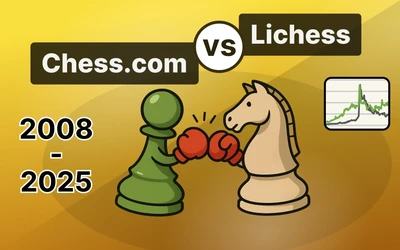
Yet Another Adult Improver Chess Blog 06
Bots Test — Tying It All TogetherRecap
The first phase was all about drills: one week of exercises, no blitz or bullet. The goal was simply to rewire habits. Blitz and bullet ingrain shortcuts and rushed decisions — exactly what we’re trying to unlearn.
Here’s what the exercises were meant to build:
- Scanning (L1): Build the instinct of looking at the whole board instead of grabbing the first shiny move.
- Simple tactics (H): Recognition and validation.
Pattern recognition only comes from constant exposure. This exercise, with 40 positions per session, gave us the reps we need. Just like I’d recognize my shih tzu Gnocchi instantly from any angle because I see her every day.
Going for perfect sessions also trained us to validate patterns, not just spot them. It’s like getting bitten while trying to pet a random shih tzu, only to realize it’s not my Gnocchi. Recognition alone isn’t enough, we need confirmation. - Safety checks (S) + L2: Train the habit of eliminating unsafe moves. These drills made safety part of our move selection, not an afterthought.
- Daily easy puzzles: Light calculation practice in a controlled setting. Well within our skill level — just enough to sharpen short calculations without overload.
Along the way, you probably noticed something important: mistakes came either from skill gaps or habit breakdowns. That distinction matters later when we troubleshoot. But since the exercises were deliberately easy, most misses probably came from habits slipping, not lack of skill.
Applying the above in actual games would then mean having a consistent process along these lines.
- Start with a decent scan of the board. No need to count every legal move, but the L1 exercise should have built the habit and sharpened scan quality.
- If a simple tactical pattern seems present, verify it before playing.
- If no pattern appears, choose from the other reasonable moves you’ve scanned.
- Check for safety, eliminate any move that fails the safety or opponent-scan test.
- Play the move that is both safe and appealing.
Seems to me that if we do this consistently, there’s no reason for us to commit STBs in real games.
Sustaining the Habit Loop
In the exercises, you practiced these steps one puzzle at a time. If you slipped on a puzzle, chances are you skipped one of the steps above.
The bots test raises the bar: now you need to sustain this loop every single move, across an entire game. That’s the real test of whether scanning, verifying, and safety checks have become automatic enough to hold up during live play.
The Bots Test
We want a no-pressure environment to measure two things:
- Hit rate: Did we spot and exploit the opponent’s SUBs? If not, that’s an SMB.
- Blunder avoidance: Did we avoid SUBs ourselves?
The target is zero simple tactical blunders — no SUBs and no SMBs. Winning or losing doesn’t matter (we’ll probably win most games anyway). What matters is whether we can keep our STB rate at zero.
How we’ll test:
- Play 10 games against Beginner and Intermediate Chess.com bots.
- These bots are weak enough to make simple unsafe blunders (giving us chances to test hit rate) but not so strong that the games introduce other complications.
- Import the games into Lichess and run auto-analysis. We stick with Lichess since its blunder definition is our benchmark.
If you can play 10 clean games here, you’ve shown you can go 400 moves without a single simple tactical blunder under easy conditions. That’s your baseline.
What’s Next
If you scored zero STBs: Perfect. Under no-pressure conditions you can sustain the habit loop cleanly, which is the baseline we want. You’re ready to carry these habits into rated rapid games, knowing they won’t hold perfectly but should still reduce your simple tactical blunder rate.
If you slipped a few times: That’s fine, but be realistic. If you can’t sustain the habit loop against bots that blunder often and never pressure you with strong moves, or on the clock, you won’t hold low STBs against humans of your own level. The habits just aren’t solid yet. The best move is to go back for another week of exercises, stack up more perfect sessions, and then retake the bots test.
From here, it’s up to you: continue straight into 10|0 rated games to see how much transfers, or double down on another week of exercises to strengthen your foundation. Either way, the exercises to strengthen our habit loop stay active throughout this training plan.
My Journey
As for me, I wasn’t too strict with my pure exercise week. The only thing I managed to do daily was the “one easier puzzle a day.” Beyond that, I fit in a couple of simple tactical pattern sessions and one session of simple tactics move-safety checks. I also played some blitz games here and there.
Even with that light load and some blitz, I felt the good habits resurfacing. Part of that is because I’ve done a “pure exercises week” before, so the foundation wasn’t completely gone. With that in mind, I decided to go ahead with the bots test.
If I perform poorly, I’ll circle back and redo the pure exercise week properly this time. If I perform well, maybe I’ll build up enough confidence to move straight into rated 10|0 games as planned.
Game 1 of My Bots Test
As an example, here’s game 1 of my bots test.
Here’s a game against Milica, a bot rated 550. https://www.chess.com/game/computer/411466581?move=0
Here are a couple of significant positions from the game.
Here, I played 9. Nxd4?? which Lichess tagged as a blunder. The recommended move is 9. Nc3. What kind of sorcery is this? So I played through both variations up to move 14. That’s 12 ply total. And what do we see, still level on material. Nothing tactical about this. Out of curiosity, I also played through with other tactical variations, these became complex pretty quickly. Nothing simple about this. It's a blunder alright, but it's neither simple nor tactical. So I’m not tagging it as an STB.
As some sort of guide, we might ask ourselves, what kind of training do I need to do to avoid these kinds of blunders moving forward? Seems to me like I might need to really learn the Ruy Lopez, or maybe train myself with hard calculations.
If the solution to solving such blunders involve more complicated exercises, it might be safe to say that this is beyond my pay grade at this point. This is not an STB.
This is where it gets hairy. I’m up a piece, and she is offering a queen trade.
But let’s first remember how Lichess tags blunders. Lichess Accuracy metric
Lichess doesn’t do it using stockfish evaluation directly. Instead, it converts the evaluation into a win rate, if the win rate drops significantly because of your move, Lichess will call that a blunder.
As a quick example, if the current eval is at +0.4 and your move made it -5.0, a 5 point eval drop. Win rate at +0.4 is 50% and now after your move, that expected win rate is now at 15%, a massive 35% drop. Lichess will tag it as a blunder. But if the score is already at -15, and your move turns it into a -20, also a 5 point eval drop, but that won't even register much in the win rate. Lichess will not tag it as a blunder.
Conversely, it works the same way when you miss winning shots. For example, if the opponent makes a move which gives you +5 eval (85% win rate), and you miss it, going back to 0.0 eval (50% win rate), Lichess will tag it as a blunder.
So here, in my position, If I go for a queen trade, I’ll be left with an extra piece, that’s around +3, and with a very good position that's maybe another +2 points, for a total of +5 evaluation. A stockfish evaluation of +5 is around 88% win rate in their table. So it’s still winning.
But remember, this is not about winning. If there’s a much better move, let’s say mate in a few moves, the win rate goes up to 99%. So if I go for a queen trade while a mate in X is floating in the air, that’s an 11% drop in my win expectation. Lichess will surely call that a blunder.
And in this bots test exercise, I don’t care about winning or losing, I’m scared of the Lichess Blunder Police.
So I paused. And then scanned.
Here’s my thought process:
After scanning I saw 16. Rd1+, trying to remove her king from defending the queen. But she still has 16. ... Bd6. Maybe 17. Ba4 can then work here.
But since I scanned, I didn’t have the bias of thinking of Ba4 only as a follow up move. Even if it was low on my candidates list since it’s a free piece, I knew that we physically have Ba4 available as a first move.
So what if 16. Ba4 first then? It’s a pin so my queen is safe, a good start. Now, there are only two options I need to check. The first is if she moves anything else, I take the queen. The second is if she takes the bishop 16. ... Qxa4. From here, it’s easy, 17. Rd1+ Ke7 18. Qd6+ Ke8 19. Qd8#, or as in the game, 17. ... Bd6 18. Qxd6+ Ke8 19. Qd8#.
And it’s good that I didn’t miss it. That would’ve been disappointing, since this position is well within my calculation skill. Missing it would’ve pointed to poor habits, not lack of ability.
This is exactly why the loop matters. If I had rushed into the queen trade, Lichess would’ve tagged it a blunder (dropping my win rate from ~99% to ~88%). But by pausing and running the 5-step process, I avoided a habit breakdown and found the cute sac finish.
So Game 1 ends clean: zero STBs, one happy adult improver. More importantly, the habit loop survived its first full-game test.
Time to proceed with the rest of the bots test.
You may also like
 FM MathiCasa
FM MathiCasaChess Football: A Fun and Creative Variant
Where chess pieces become "players" and the traditional chessboard turns into a soccer field GnocchiPup
GnocchiPupYet Another Adult Improver Chess Blog 04
My Benchmark Games ChessMonitor_Stats
ChessMonitor_StatsWhere do Grandmasters play Chess? - Lichess vs. Chess.com
This is the first large-scale analysis of Grandmaster activity across Chess.com and Lichess from 200… CM HGabor
CM HGaborHow titled players lie to you
This post is a word of warning for the average club player. As the chess world is becoming increasin… GnocchiPup
GnocchiPupYet Another Adult Improver Chess Blog 07
Bots Test - Beginners GnocchiPup
GnocchiPup